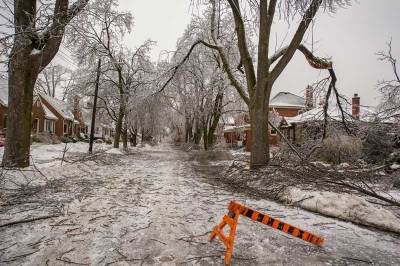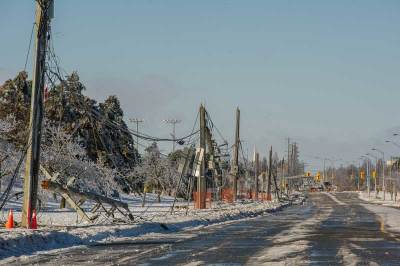
STORY BY MEHREEN SHAHID
Even though work emails had been pouring in, nothing could have painted a picture of what awaited her back in Brampton.
Kathryn Trojan Stelmaszynski’s red-eye flight from Vancouver landed early Monday morning in Toronto. And she went straight to work, stopping only to pick up her car, which was parked on a downtown Toronto street.
“There was a whole layer of ice on my car,” she said. “The drive in was an experience, lots of trees had been knocked down there was debris all over, lots of snow and ice and hydro crews were working away on the roadsides. That’s what we saw for the next seven to 10 days, working around the clock.”
Southern Ontario was hit by severe, icy winds starting December 20, within two days cities around the Greater Toronto Area were frozen and under siege by snow and icy rains. During the three days of weather bashing, flights were delayed, roads were off limits, schools and offices were closed and thousands of residents across the GTA lost power.
Stelmaszynski, who works as a community preparedness adviser with the City of Brampton, had been following weather channels to stay updated about developments in the forecast ice storm.
“On the Saturday preceding my arrival, my manager had co-ordinated with the parks department and all the other departments to set up a crisis command centre in city hall,” she said. “Laptops and phones were setup, and meetings were happening regularly. We had a whole list of city departments bringing in status updates.”
MORE RELATED TO THIS STORY:
- Capturing the “Icepocalypse” in story and image
- Student photography of the “Icpocalypse”
- St. John Ambulance hosts CPR training event
By the time she was back at her desk, Monday morning, reports that had been trickling in all weekend showed 50,000 to 60,000 trees had been damaged, more than 3,200 streets needed to be cleaned and more than 350,000 residents were without power. And more complaints were anticipated.
All departments had to come together and co-ordinate efforts to help those in need and clear out city space. But resources fell short.
“We activated our emergency plan within hours of seeing that this is going to be a serious situation. About 9 a.m. on Saturday, Dec 21, we decided to activate the plan,” said Alain Normand, manager of Brampton’s emergency management office. “It was right before Christmas and it made it difficult to reach the people who are normally available.”
Other cities stepped in to help out those struck in the GTA.

“Windsor, Sudbury and Ottawa sent us crews,” said Normand. “Because they have the same kind of standards and same regulations, we could use their services.”
However, managing logistics for the visiting crews was still a City of Brampton responsibility. The crews had to be housed, fed, provided transport and gasoline to get to and from work sites around the city. Some even had to stay overnight at sites because getting back would mean getting in the way of other crews that were working to clear the roads.
Stelmaszynski and Paul Hassanally, her fellow graduate from Sheridan’s emergency management program, were working around to the clock to co-ordinate efforts and get help out to those in need.
“My role throughout most of the ice storm was mostly planning and command,” said Hassanally, who is corporate preparedness adviser for the City of Brampton. “A lot of the time we would be receiving information from crews working in the ice storm. We had briefings twice a day.”
The teams managing various services at city hall were focusing on similar issues. “Restoring power was a huge priority for hydro,” said Stelmaszynski, 27. “Communicating to the residents where they could find more information and where to go for power, for sleep, for a hot shower were priority for us.” The city opened two over-night shelters and eight warming centres to the public.
The Sheridan grad said that once the rain and snow stopped the focus shifted on how to clean up, restore power and get the city back to where it was.
Stelmaszynski’s role involves a lot of support work. They help link one department to another.
Even in circumstances as severe as those experienced in the ice storm of 2013, cities and people didn’t come at a stand still.
“We didn’t want residents going out and trying to clear trees,” said Stelmaszynski. “How quickly it would happen was of interest to both the residents and to the city.”
Hassanally explained that there were two levels of response happening within the city: one was tactical, dealing with 50 crews, and the team at city hall managing everything else.
“Another big part of my role was to do with the Region of Peel and Ontario government,” said the 29-year-old. “Because of blackout communication was a challenge. We were developing key messages twice a day.” The city’s websites were constantly being updated and staff were taking calls and issuing media releases.
According to Hassanally, statistics collected during the emergency week revealed that on Sunday, Dec. 22, 2013, the call centre received close to 6,000 calls whereas the number of calls received on a non-emergency Sunday is only 350, Hassanally said. Similarly, on Monday, the department received close to 700 emails—double the number of emails received in a month.
The crisis command centre remained open for two weeks.

“Our office made sure that there was someone there during day hours,” said Stelmaszynski. “We gathered information and helped push it out using social media with the help of the strategic communications division in the city.”
One feature unique to her role in the crisis was to co-ordinate with a volunteer group called the Community Emergency Response Volunteers to help staff the warming centres.
“We were aware that some residents in Brampton would be harder to reach and in these cases CERVs worked really well,” she added.
In Stelmaszynski’s opinion, the probability of tackling the emergency was raised because of all the pre-emergency work done by the city. Communication and outreach still needs to be worked on, she said.
“If there is someone who doesn’t have Internet access or a smart phone, which the older population in Brampton won’t have, there is no radio station that will come to the rescue,” she said. “So we have to figure out how to communicate with those residents.”
In such cases, residents would call in to the city’s emergency line to gather more information and the city needs to be timely in gathering and disseminating the information to those seeking it.
Hassanally noted one factor different from academic studies was how that unlike corporate planning committees anticipate, this emergency did not happen during normal business days. It worked out in the city’s favour as one of its roles is to ensure businesses continue as usual, but that was less of a concern during the ice storm.
His boss, Normand, said a well-established structure along with training exercises and drills works well. He also mentioned the offers made by Brampton residents.
IN CASE OF AN EMERGENCY:
To be prepared for a weather-related emergency, the City of Brampton emergency management department recommends that you:
- Know the risks.
- Make a plan. But home emergency plans don’t need to be multi-page documents. It’s about sitting down at home and having a conversation with your family and talk about what you’re going to do during an emergency.
- Having escape routes out of your house in case of a fire.
- Have an emergency kit at home. Non-perishable food, lots of bottled water, photocopies of your important documents, passports, driver’s licences, insurance certificates, small amount of cash, changes of clothes, personal hygiene items, medicine, copies of prescriptions and anything else that helps your family survive the emergency.
- Contact numbers for your neighbours.
- Make sure your children have all emergency numbers as well.
“A lot of people called in and wanted to help but we didn’t have any system to register and take in volunteer help,” he said, praising the humanitarian spirit displayed by citizens. “People wanted to come in and prepare food, but there are some regulations for health hygiene, when and how it is prepared. Instead, we told them to go back to their street, and if there were people in need of food on their street and neighbourhood they could offer the food there.”
Keeping in mind the response from the community, Normand wants future emergency policies to include ways of inducting on-the-spot volunteers into official teams somehow. He thinks maybe there is a way volunteers can be assigned to tasks that are not bound by regulations. One way around this, he feels, is for volunteers already registered with agencies to come forward.
Normand said to encourage volunteers to come forward in times of disaster, the city refers people, “to join the Red Cross or church agencies so that in an emergency we know these recognized organizations have done the necessary background checks and we can take them [the volunteers] on.”
Even though the emergency management department wrapped up its command centre at city hall in the first week of January, Stelmaszynski said later into the year clean-up crews were still chipping away at removing debris and cleaning up parks and streets to make them livable once more come spring.
A massive clean up that required the city to pull together all its resources and rely on the charitable behaviour of residents and other municipalities helped get Brampton back on its feet.
